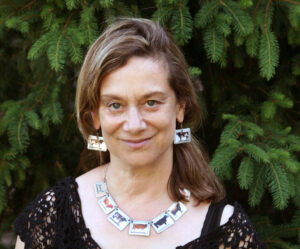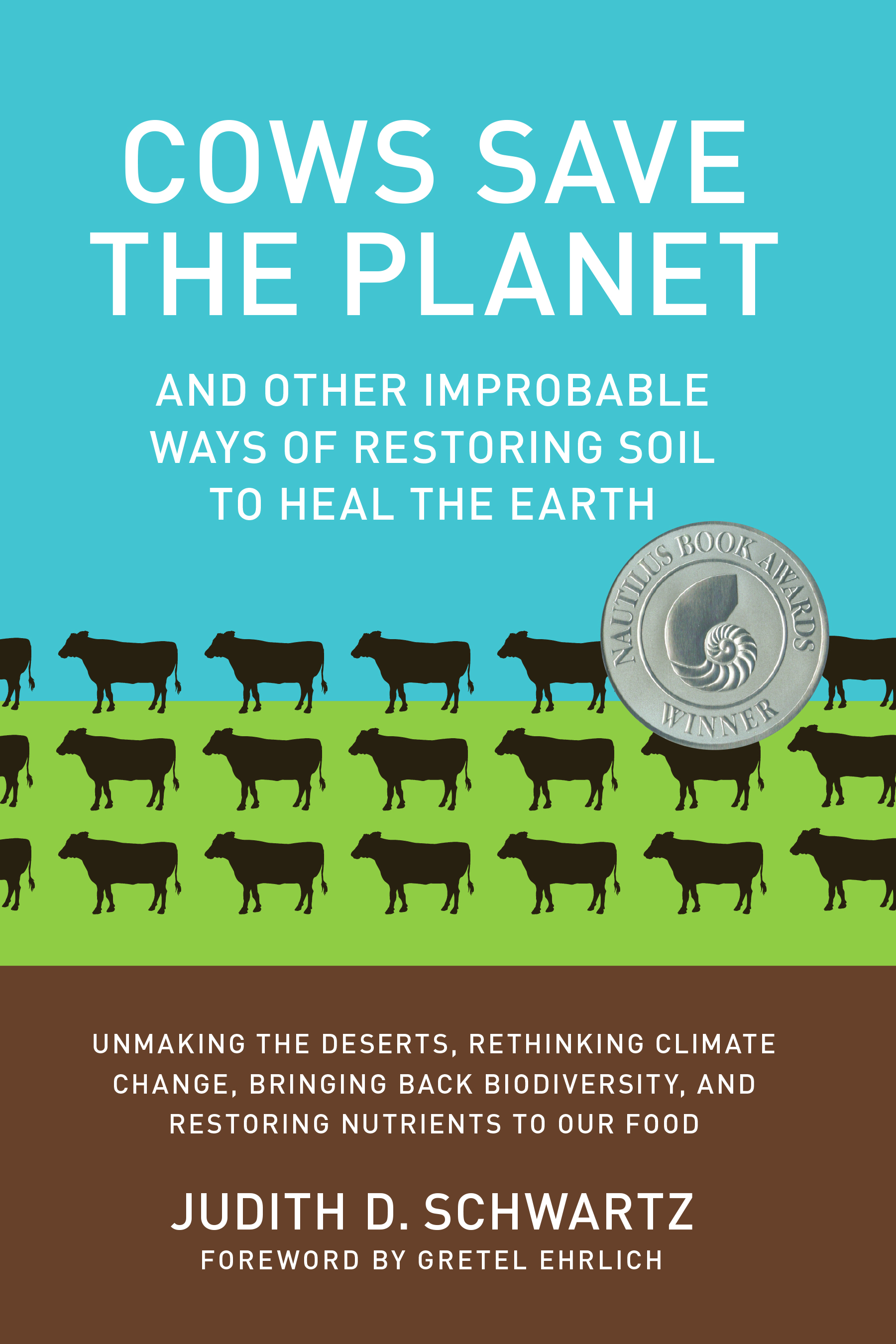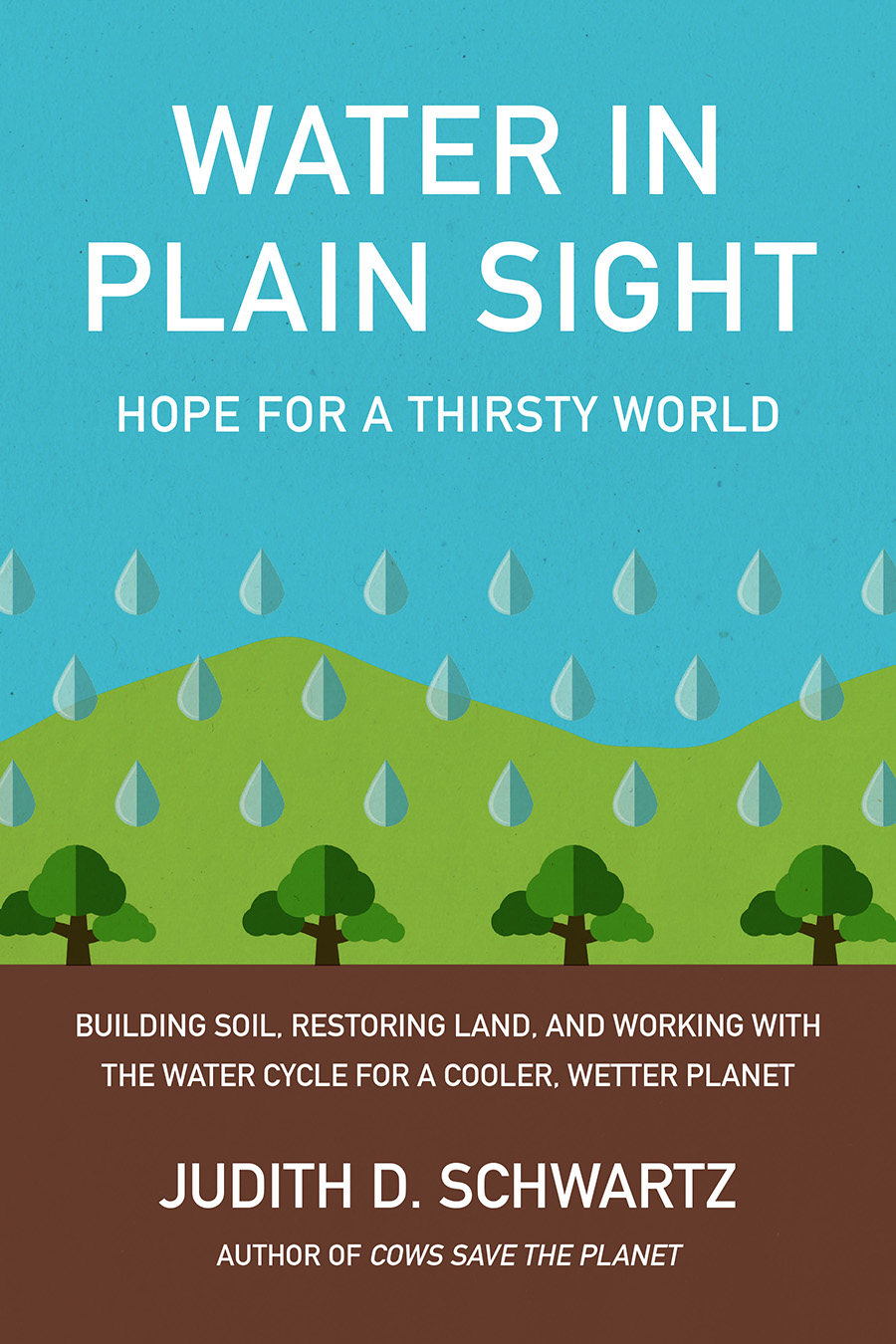Cows Save the Planet
And Other Improbable Ways of Restoring Soil to Heal the Earth
In Cows Save the Planet, journalist Judith D. Schwartz looks at soil as a crucible for our many overlapping environmental, economic, and social crises.
Schwartz reveals that for many of these problems—climate change, desertification, biodiversity loss, droughts, floods, wildfires, rural poverty, malnutrition, and obesity—there are positive, alternative scenarios to the degradation and devastation we face. In each case, our ability to turn these crises into opportunities depends on how we treat the soil.
Drawing on the work of thinkers and doers, renegade scientists and institutional whistleblowers from around the world, Schwartz challenges much of the conventional thinking about global warming and other problems. For example, land can suffer from undergrazing as well as overgrazing, since certain landscapes, such as grasslands, require the disturbance from livestock to thrive. Regarding climate, when we focus on carbon dioxide, we neglect the central role of water in soil—”green water”—in temperature regulation. And much of the carbon dioxide that burdens the atmosphere is not the result of fuel emissions, but from agriculture; returning carbon to the soil not only reduces carbon dioxide levels but also enhances soil fertility.
Cows Save the Planet is at once a primer on soil’s pivotal role in our ecology and economy, a call to action, and an antidote to the despair that environmental news so often leaves us with.
Listen to an audiobook sample!
Introduction - Cows Save the Planet?Awards
- 2014 Nautilus Award, Silver in Green Living/Sustainability
Reviews and Praise
Permaculture-
Cows Save The Planet is a wonderfully comprehensive book, challenging some of the current popular theory relating to climate change and the mending of our damaged planet. Judith D.Schwartz has travelled to meet and interview an impressive mix of people, some well known names from around the world (Allan Savory, Christine Jones for example), and many who I have never heard of prior to reading her book. All, however, in some way, are undertaking a wealth of inspirational and essential work relating to healing the world's soil.
At its core, Schwartz's work provides us with solutions and hope, for spiraling environmental and social destruction, through the rehabilitation of the earth beneath our feet. Each chapter of the book is a work in itself but there is also a natural flow and progression in the writing as Schwartz invites us to witness her journey, addressing climate change, loss of biodiversity, desertification, droughts, floods and human health.
The new thinking and new understanding you gain from reading and then rereading Schwartz's work gives us motivation and determination to want to make some very real positive changes in our communities and lands. I can recommend it to all."
More Reviews and Praise
"Here's a secret climate-change activists and energy-efficiency and renewable-energy promoters neglect: Nature is designed to be self-healing, and her most profound 'tool' is photosynthesis. 'Free' sunlight is the best energy source to extract carbon dioxide from the atmosphere, while also producing organic matter and oxygen—and a by-product is healthier soil, forests, wetlands, and ecosystems. When politicians, policy leaders, and activists get serious about cost-effective solutions to climate change, then a top priority will be ecological restoration to harvest and store carbon naturally, and Judith Schwartz's new book will provide a destination and map."--Will Raap, founder, Gardener's Supply and Intervale Center
ForeWord Reviews-
"Could it really be this easy? Improve soil fertility, preserve biodiversity, reduce obesity, and halt climate change by having more cows graze more land to help 'fix' more carbon into the soil? Well, solving the world’s problems may not be quite that easy, but journalist Judith Schwartz raises these and many equally intriguing questions in Cows Save the Planet: And Other Improbable Ways of Restoring Soil to Heal the Earth.
Her book focuses on sustaining and improving the quality of soil, as well as the economic, environmental, and societal benefits we could realize by making that change. Around the globe, topsoil is lost at an alarming rate: up to 40 times faster than we’re generating it (in China and India, particularly). The consequences include a rapid increase in deserts, droughts, floods, and wildfires, not to mention a loss in the fertility of soil and the nutritional quality of food.
The losses occur rapidly, but the solutions can work almost as quickly. The soil can be rebuilt from the bottom up, and nature can heal itself with surprising efficiency. For instance, undergrazing can damage the soil as much as overgrazing. study the historical movements of herds of grazing animals over the grasslands and plains of much of the globe, and adjust livestock and land management principles accordingly, the author suggests. Allow for the organic material, natural microbes, and insect life that facilitate plant diversity and soil enrichment. The resulting impact will be far-reaching and transformational on the land, climate, and crops.
Schwartz refers frequently to the holistic management principles outlined by agriculturist Allan Savory, views that some consider controversial. Schwartz does not attempt to bridge the gap between these holistic ideals and current practices in the industrial food complex but instead grounds her view in narratives of earnest farmers and ranchers from Australia to Vermont who put these soil management principles into practice.
A journalist who has written on marriage, therapy, and other diverse topics, Schwartz tackles complex topics such as the chemistry of the carbon cycle and photosynthesis and counters the myths about cows and methane with an accessible, conversational voice. Her study is lucid, enlightening, and often surprising. It is also an enjoyable, compelling read that will appeal to a wide audience, offering hopeful and creative solutions to some of the most daunting questions of our day."
Booklist-
"The earth beneath our feet is something most of us acknowledge is important for raising crops and nourishing lawns, yet few of us realize just how vital it is to our planet's overall health. Inviting readers to roll up their pant legs and wade with her into the dirt, veteran journalist [Judith] Schwartz reveals a wealth of detail about soil's beneficial properties and presents a compelling case that proper soil management can end escalating worldwide desertification and slow, or even arrest, global warming. While these assertions may sound surprising, Schwartz collects abundant testimony from leading-edge soil scientists and activists, such as noted Zimbabwe biologist and rancher Allan Savory, whose sophisticated sheep- and cow-herding methods in several countries have completely restored arid grasslands in less than a decade. She also highlights evidence from little-known studies demonstrating that soil restoration techniques can sequester about a billion tons of atmospheric carbon per year, potentially neutralizing damaging greenhouse gases. A well-written and persuasive manifesto for healing earth's environmental woes with one of its most underappreciated resources."
“Judith Schwartz’s book gives us not just hope but also a sense that we humans—serial destroyers that we are—can actually turn the climate crisis around. This amazing book, wide-reaching in its research, offers nothing less than solutions for healing the planet.”--Gretel Ehrlich, from the foreword
“Judith Schwartz takes a fascinating look at the world right beneath our feet. Cows Save the Planet is a surprising, informative, and ultimately hopeful book.”--Elizabeth Kolbert, author of Field Notes from a Catastrophe: Man, Nature, and Climate Change
“In Cows Save the Planet, Judith Schwartz takes us on a fascinating, John McPhee-style journey into the world of soil rehabilitation. The eclectic group of farmers, ranchers, researchers, and environmentalists she visits have one thing in common: they all believe in the importance of organic matter in the soil for solving our most pressing environmental issues. Some of the innovative techniques they use to increase the vitality of their soil include no-tillage, using deep-rooted perennial grasses, cover crops, mulching, and, surprisingly, grazing large herds of animals according to a program called 'holistic management.' Imagine, a book about soil that’s a real page turner!”--Larry Korn, editor of The One-Straw Revolution and Sowing Seeds in the Desert, by Masanobu Fukuoka
“Judith Schwartz reminds us that sustainable range management is as much about the microbes in the soil and their feedback loops with cattle as it is about the cattle themselves. When I finally go home on the range to be composted, I want to be part of the miraculous cycle of rangeland renewal that is managed in the way that Schwartz describes so well.”--Gary Nabhan, author of Desert Terroir, Kellogg Endowed Chair in Sustainable Food Systems, University of Arizona
About The Author
| Pages: | 240 pages |
| Size: | 6 x 9 inch |
| Publisher: | Chelsea Green Publishing |
| US Pub. Date: | May 20, 2013 |
| UK Pub. Date: | June 26, 2013 |
| Paperback: | 9781603584326 |
Available In/Retail Price
Paperback, 240 pages, $17.95USD, £13.99GBPEXCERPTS
REVIEWS
MEDIA & EVENT INQUIRIES
Media Inquiries:
Contact Publicity at: [email protected] or (802) 295-6300 x 127
Event Inquiries:
To set up an author appearance or event contact Darrell Koerner at [email protected]
Review Copies:
Click here to request a review copy of one of our books.
Rights & Permissions
Email us for rights & permissions inquiries.
SALES CONTACTS
Special, Corporate and Academic Sales
Darrell Koerner
[email protected]
(303) 963-5612
Trade and Library Sales
Kirsten Drew
Book Strategy Manager
[email protected]
Independent Bookstore Sales
To place a retail wholesale order, please contact the appropriate regional representative.
Canadian and Overseas Trade Distribution
To place an international wholesale order, please contact the appropriate foreign trade distributor.
Academic Kit
Request a desk or evaluation copy.




